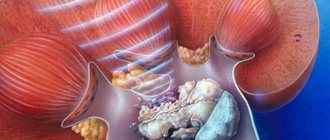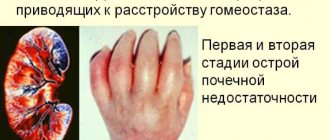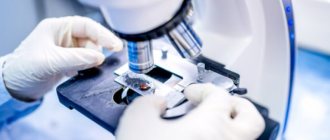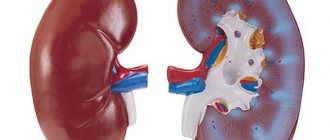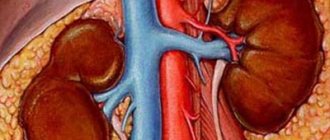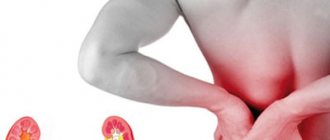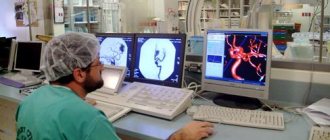The main causes of kidney failure
Experts identify three types of causes that affect kidney function:
- Prerenal causes. As a rule, they are associated with impaired blood supply to the urinary organs. That is, if a small flow of blood passes through the kidneys or at a slow speed, then the organs begin to decline. The speed of blood flow depends entirely on the level of blood pressure. This is why hypotensive and hypertensive patients suffer from renal pathologies more often than others. At the same time, kidney diseases always and invariably accompany diseases of the heart and vascular system. One of the common causes of prerenal renal dysfunction is the patient's shock due to burns, injuries, strong blows, myocardial infarction, blood poisoning, anaphylactic shock, etc. As a result of such conditions, the amount of blood in the kidneys is sharply reduced. There is a disorder in the filtration function of the kidneys. Hence, the amount of primary urine sharply decreases, which means that the human body is poisoned by toxins.
- Renal reasons. These include any renal pathology during which the tissue of the organ, the parenchyma, suffers. These can be all kinds of neoplasms in the kidneys, glomerulonephritis and nephritis of other etiologies, strong toxic effects on the kidneys from arsenic, mercury, etc. poisons, as well as renal vein thrombosis and kidney infarction. In addition, renal causes of renal dysfunction include bilateral nephrectomy (removal of organs), which is incompatible with life, or severe trauma to both organs with separation of one or both from the vascular pedicle.
- Postrenal reasons. These include obstructive processes in organs. These occur in most cases against the background of nephrolithiasis (urolithiasis), hematoma of the parenchyma after injury, and various tumors.
Acute and chronic kidney failure
Renal dysfunction can be either acute or chronic. Moreover, the second option is more unfavorable for a person, since the acute phase of the pathology has more or less pronounced symptoms. And this, in turn, makes it possible to combat the cause and effect of organ dysfunction. Chronic renal dysfunction may not manifest itself for a long time, but becomes obvious already in the final stages, when nothing can be done.
Chronic renal failure is often caused by chronic pathologies in the urinary organs. These are:
- Chronic pyelonephritis, which over time leads to shrinkage of the organ;
- Chronic glomerulonephritis, which impairs filtration in the kidneys.
- Chronic kidney stones;
- Diabetes;
- Hereditary nephritis;
- Atherosclerosis of the renal vessels.
Pathogenesis of renal edema
Read:- I According to etiopathogenesis
- I. Pathogenesis of endogenous intoxication
- III. State your ideas about the pathogenesis of the syndromes you have identified in this disease.
- III. Pathogenesis
- IV. Make a diagram of the pathogenesis of pneumonia
- IX. Etiology, pathogenesis,
- IX.2. Pathogenesis
- VI.2. Pathogenesis
- VII.2. Pathogenesis
- VIII. Etiology and pathogenesis
If the kidneys are damaged, swelling may occur:
1) nephrotic (with nephrosis, i.e. damage to the tubules) and
2) nephritic (with nephritis - damage to the glomeruli of the kidneys).
The pathogenesis of edema in nephrosis is damage predominantly to the renal tubular apparatus → increased permeability of the renal filter to proteins - albuminuria → hypoalbuminemia → decreased oncotic pressure of the blood → increased outflow of water into the tissue - insufficiency of reverse lymph flow → decreased plasma volume → hypovolemia → increased formation of aldosterone and ADH → retention of sodium and water in the body → swelling in the morning on the face (especially the eyelids - where the skin is thinnest).
The pathogenesis of nephritic edema is associated with damage to the glomeruli - it leads to disruption of blood circulation in them, an increase in the production of renin, which increases the formation of angiotensin I and II , which activates the secretion of aldosterone. Aldosterone causes sodium and water retention → hypernatremia - through osmoreceptors it activates the secretion of ADH. ADH activates hyaluronidase in the epithelium of the renal and collecting tubules, which destroys hyaluronic acid in the capillary walls, increasing their permeability. Generalized capallaritis occurs - reverse reabsorption sharply increases, water is retained in the body, and an increase in capillary permeability leads to the entry of water into the tissues and the occurrence of edema. In this case, not only water, but also blood plasma proteins are released into the tissue. Therefore, a distinctive feature of nephritic edema is the high protein content in the interstitial fluid and increased tissue hydrophilicity. Edema is also promoted by sodium retention in tissues and an increase in osmotic pressure in them.
The pathogenesis of uremia is the retention in the body of all those toxic products (especially proteins) that are normally excreted from the body in the urine, i.e. components of urine accumulate in the blood: increase
1) residual blood nitrogen from 20-40 mg% to 500-700 mg%,
2) urea from 15-25 mg% to 400-500 mg%,
3) uric acid from 2-4 mg% to 10-20 mg%,
4) creatine from 1-1.5 mg% to 30-35 mg%,
5) indican from 0.001 mg% to 6-7 mg% (i.e. 6000-7000 times).
Poisoning of the body and increasing symptoms of intoxication occur. It is believed that poisoning is caused not by urea itself, but by ammonium carbonate and carbamic acid. Since urea is released in large quantities in the intestines, under the influence of intestinal bacteria it turns into the toxic form carbonate and carbamic acid , which, when absorbed from the intestines, poisons the body. Of great importance in the mechanisms of intoxication in uremia is the accumulation of phenolic compounds in the blood: phenol, cresol, indoleacetic and other acids. What is uremia - a complex symptom complex of phenomena of self-poisoning of the body with products of nitrogen metabolism, urea, uric acid and other substances accumulating in the body. This is the final cessation of the filtration and concentration ability of the kidneys.
1. Intoxication with uremia is characterized by certain phenomena on the part of the central nervous system: constant, persistent, sharp headaches that do not stop day and night as a result of the influence of toxic substances, impaired kinin metabolism and the occurrence of cerebral edema with certain symptoms: drowsiness, delirium, hallucinations, hearing loss and vision → loss of consciousness - uremic coma.
2. Irritation by products of nitrogen metabolism → persistent, very painful vomiting (painful - of central origin on an empty stomach against the background of aversion to meat and loss of appetite). When vomiting, an empty stomach seems to turn inside out, without bringing relief. Uremic gastritis and bronchitis develop, and the breath smells like urine (foetor uraemicus).
3. Urea is secreted on the skin in the form of salt.
4. DC intoxication leads to Cheyne-Stokes respiration.
Nephrotic syndrome. Kidney failure can be a consequence of the so-called nephrotic syndrome, which can be a consequence of:
1) primary kidney diseases: glomerulonephritis - inflammation of the glomeruli of the kidneys, amyloidosis - dystrophic changes in the tubules, acute and chronic pyelonephritis, kidney tumors, nephropathy in pregnant women.
2) secondary diseases - syphilis, systemic lupus erythematosus, burn disease, diabetes mellitus, capillary glomerulonephritis or Kimmelstiel-Wilson disease, blood diseases - leukemia, nephrotic syndrome manifests itself with massive proteinuria and, as a consequence, hypoproteinemia → decrease in oncotic pressure of the blood, release of fluid into tissue → development of edema.
Filtration mechanisms . It has now been established that filtration and hydrostatic pressure are actively regulated by the juxtaglomerular apparatus (JGA), discovered by scientists Yuka and Pickeling. The cells of this apparatus are 1) JGA receptors and 2) its effectors. They have the ability to secrete renin . The amount of renin released depends on the tension of the cell membrane, and this depends on the blood pressure in the glomeruli of the kidneys. Renin itself is not active, it affects α2-globulin (angiotensinogen) - it cleaves off a peptide of 13 amino acids - angiotensin-I, which, under the action of dipeptide carboxypeptidase in the blood, is converted into angiotensin II (3 more amino acids are cleaved off).
It has been established that renin is released in the form of granules when the cell membrane is tense due to a drop in blood pressure in the glomeruli. In humans, when the posterior lobe of the pituitary gland and ADH secretion ceases, diuresis can reach theoretical maximum values. This is explained by the fact that ADH promotes the reabsorption of water from the tubules into the blood. In the absence of this hormone, active reabsorption of water in the distal segment of the loop of Henle completely stops - diuresis = 17 cm3/min = 25 l/day. Diabetes insipidus occurs.
Date added: 2015-08-06 | Views: 1679 | Copyright infringement
| | | | | | | | | | | | | | | | | | | | | | 23 | | | | | | | | | | | | | | | |
